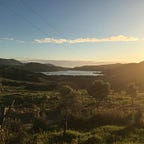Reflections from the crypt: Far North issues need Far North solutions (#1 of #2)
I remember early-2016 and being newly-wed after many years of cohabitating with my hoa tane with Far North whakapapa, and on top of that newly arrived to the Far North from Wellington, eyes and heart filled to the brim with the beauty and energy of Te Tai Tokerau. Eight months later is when the blinkers well and truly fell off, and I was left thinking, ‘what the hell is going on here’? During that time, Kaitāia and its surrounding areas were in the grip of a youth suicide cluster recurring at a frequency that was beginning to seriously concern locals, whānau and parents; and turn heads with bureaucrats and politicians alike. At the time, national and regional agencies were rallying to help, however that intervention was said to be months away, and in the end did not turn out to be what was promised. I then saw in the newspaper that the Mental Health Foundation would do something in 2017, obviously about a year too late, and in fact that didn’t amount to much neither. Intergenerationally experienced health and social issues required immediate intervention, not the hospital pass that seemed to be servicing it with very little effect.
There is (still) a gap here that needs expertise sourced from these communities. Too many short-term, externally located, time limited initiatives promise deliverables and outcomes that at the end of their shelf life look great on paper, but actually didn’t amount to much on the ground for our people and communities. What these agencies do not capture is why these issues are consistently resurfacing here in the Far North, and they don’t stick around long enough to work it out anyway. On top of that, the current health and social services sector in Kaitāia find themselves tied up in their contracts, looking after their own organisations and client bases. Regardless, nothing of what has been described here has been far-reaching or successful in cohesively addressing the health and social issues that continue to persist in the Far North.
At the time, I was lecturing into a social work bachelors degree based in Kaitāia (it being the only BA level programme delivered in Kaitāia), working in a team of two lecturers that were teaching locally. As then qualified and registered social work lecturers, we lived in these Far North communities and had a very real opportunity to observe from the lens of expertise and experience that we collectively held. What we both offered as well was some independence from the silos that exist up here, and the sincere belief that some form of capacity needed to be built into these communities, which we would have helped with had there been an invitation to do so.
It is known in the Far North that many of its people like to keep things straightforward and simple, so in the spirit of directness, here is what I think needed to happen. An entity needed to be created, with the mission to work through why these recurring issues were and still are plaguing the Far North. The answers should naturally be coming from these communities, and they need to be owned and designed from these communities. This is something that is still required here in the Far North. What I think it looks like is a long-term funded innovation hub-type entity that is grounded in local knowledge, mātauranga Māori and some form of systems/design approach.
Working synergistically is what these Far North communities require. What tends to happen I liken to the roof of a whare (house) that leaks in several places when it rains. There is only enough material to plug up one hole but with the rest, the family put buckets out. Meanwhile, the bones of the house are slowly rotting. This is what is happening in the Far North. We have funding streams that plug a gap in the community, but tend to work in silos often to the detriment of other health and social issues. Or, put simply in the words of systems guru Donella Meadows, we need to stop “[d]iddling with the details, arranging the deck chairs on the Titanic”. The ship is sinking and people are trying to make things look nice and in order, when really it becomes an exercise in futility because eventually all of us, deck chairs included, are going to end up in the drink.
So I think what we (the royal ‘we’) need is to enable our communities to withstand the incessant tide of hopelessness. This needs a systems approach from local people who are passionate about working in an innovative way to make impactful systems change for the Far North. I think that this is an investment in finding local Far North solutions to local Far North issues. There are people out there who have a vested interest in ensuring that these communities are healthy and well, and that our children and families are safe, so any outcome from this will have to be long-term and sustainable. That’s what a culturally-based, locally-situated innovations hub would offer, and what I will shortly be providing a comprehensive overview of in reflection #2.
